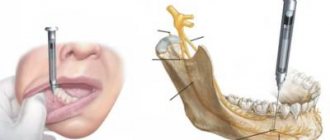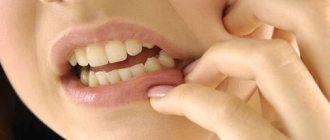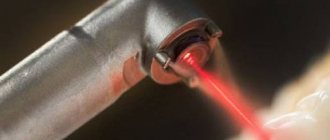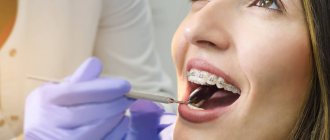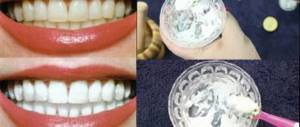Microabrasion – gentle polishing of enamel to remove plaque and prevent caries
Every day, the enamel of our teeth is affected by a huge number of external factors.
Excessive consumption of sweets, coffee and tea, smoking - all this leads to gradual demineralization of the protective layer of teeth and, as a result, a change in its color. It is important to understand that this is not only an aesthetic problem. Under bacterial plaque, hard tissues are quickly destroyed, which in the absence of regular hygiene inevitably leads to the onset of carious processes. The situation can be corrected in the early stages using a microabrasion procedure. Microabrasion
is a gentle polishing of teeth to remove pigmented areas and prevent the development of caries. Most often, such changes include white spots, which cause aesthetic discomfort to patients.
Read more about what it is and when the technique is used further in this material.
The essence of the microabrasion method
This is a modern method that involves gentle grinding and polishing of teeth, when the doctor carefully removes the thinnest layer of enamel using a special mixture of abrasive particles. The thickness of the removed layer usually does not exceed 25-70 microns, which makes it possible to prevent excessive thinning of the enamel and, accordingly, the development of hyperesthesia, that is, its high sensitivity. In particularly difficult cases, up to 200 µm1 is removed. You can see how your teeth look before and after the procedure in the photo below.
The photo shows teeth before and after the microabrasion procedure
Such therapy is used in dentistry in cases where the patient has heavily soiled and pigmented areas on the teeth that cannot be removed using the classic method of professional cleaning. In addition, this is one of the methods for preventing the further development of carious processes if the medical history is still in the initial stages of its development. The method is effective in situations where caries has not yet had time to destroy the upper protective layer of teeth and its internal tissues, that is, it is at the stage of demineralization.
In what cases is it prescribed and when is the use of the technique contraindicated?
As mentioned above, the main indication for the procedure is the presence of pigmented areas of enamel that are not amenable to standard methods of removing contaminants. Thus, experts in the field of dentistry identify a number of other phenomena and conditions for which the procedure may be prescribed:
- hypoplasia - spotted form,
- the first stage of caries development,
- the presence of foci of demineralization,
- rough surface layer of teeth, including after orthodontic treatment.
The photo shows hypoplasia of tooth enamel.
However, the procedure is not performed if the patient is diagnosed with the following pathological conditions: tetracycline teeth, severe thinning of the enamel, the presence of erosive lesions and cracks on it, fluorosis, underdevelopment of the protective layer, wedge-shaped defects. Microabrasive treatment is also not prescribed to patients with mental disorders, diseases of the oral tissues, or individual intolerance to the components of the drugs used. The procedure is contraindicated for pregnant and lactating women, for temporary teeth and after their depulpation, as well as for poor oral hygiene.
Contraindications to microabrasion
Microabrasion, just like other medical procedures, has a number of contraindications. For example, the use of this method of combating discolorations of tooth enamel is not recommended for persons who have previously been diagnosed with the following pathologies:
- dentinogenesis imperfecta;
- cracks on the surface of the enamel layer;
- allergic reaction to components present in the abrasive gel and other drugs used during the procedure;
- periodontal diseases;
- pathological exposure of the necks of teeth;
- enamel erosion;
- amelogenesis imperfecta;
- moderate enamel hypoplasia;
- psychical deviations;
- fluorosis occurring in a destructive or erosive form;
- presence of wedge-shaped defects;
- excessive thinning of the enamel layer.
In addition, contraindications to microabrasion are:
- age-related change in the shade of the enamel layer;
- the presence of so-called “tetracycline teeth”;
- change in the shade of pulpless or baby teeth;
- carrying out orthodontic treatment;
- lactation and pregnancy;
- poor oral hygiene.
What are the pros and cons?
The technique has quite a few advantages, among which specialists and patients often highlight the lack of need for any preparation. In addition, the procedure is completely painless and does not cause any discomfort. If microabrasion is used to prevent further tissue demineralization, then after its successful implementation it is possible to avoid large-scale tooth preparation for its further restoration. In general, the technique saves in cases where other options for removing plaque and pigmentation do not help.
“They performed microabrasion on me. I found white spots on my front teeth, the doctor said this is how caries begins. After the examination, the dentist suggested grinding off a thin layer to ensure that the lesions were removed. I agreed. There was no pain at all during the procedure. Only then did sensitivity to cold and hot appear. Personally, everything went away for me literally in 3-4 days.”
Evgenia S.S., Moscow, from correspondence on the woman.ru forum
Among the disadvantages, one can highlight a fairly impressive list of restrictions on the use of the method. In addition, after the procedure, almost all patients experience increased sensitivity of the enamel layer - hyperesthesia goes away on its own within a few days, but for this you need to strictly follow the instructions of your doctor.
Step-by-step description of the process
To begin, the patient must sit comfortably in the dental chair. Despite the fact that the procedure is completely painless and does not require prior administration of anesthesia, it is important to create a psychologically comfortable environment for the person so that he can relax and allow the doctor to work in peace. Once the patient is ready, a special composition will be applied to his teeth, which includes hydrochloric acid, carborundum and silicon abrasive gel. The product is applied to the enamel using a special rubber nozzle. The paste is left for a while to soften the enamel layer a little. Afterwards it is removed using special rubber cups.
So, enamel microabrasion involves the following steps:
- First, the specialist isolates the treatment area from the mucous membrane and neighboring healthy teeth. For this, a special gel can be used, for example, “Axil” or rubber dam,
- then the dental retractor is fixed,
- an abrasive mass is applied to the surface of the enamel,
- the product is gently rubbed into the dental tissues, usually using special rotating rubber cups,
- excess mixture is removed,
- Remo-gel is applied to the affected area, stimulating the processes of restoration of damaged enamel and replenishing the lack of minerals in dental tissues,
- remineralization – carried out if there are appropriate indications,
- At the final stage, the doctor evaluates the result of treatment, advises the patient, and gives him a reminder about further dental and oral care.
The photo shows the application of the gel to teeth during microabrasion.
If there is such a need, the procedure is repeated. The duration of the rehabilitation course directly depends on the degree of contamination of the teeth and the depth of the spread of carious processes.
How is microabrasion of tooth enamel performed?
At the first stage, the dentist cleans the surface of the teeth from plaque. Using a mirror installed on the side of the incisal edge, the thickness of the enamel and the depth of pigmentation are assessed. A rubber dam is fixed - a latex scarf to isolate the mucous membrane and soft tissues. In order to qualitatively isolate the cervical area, an additional gel is applied to the gingival margin, which hardens under the influence of a photopolymer lamp. To protect the eyes from abrasive contact, the patient wears glasses.
Next, the dentist applies an abrasive preparation to the problem areas and rubs it in with rubber cups for 30-60 seconds at slow speeds, after which the abrasive is removed. The surface of the tooth is thoroughly washed with water. The visit ends with the application of a fluoride-containing drug in the form of a gel or varnish.
Efficiency and safety of the procedure
Microabrasive treatment makes it possible to completely remove pigmented stains on the surface of teeth, as well as stop carious processes at the very beginning of their development. Thus, this is not only a solution to an aesthetic problem, but also a prevention of further rapid destruction of dental tissue under the influence of pathogenic bacteria. According to statistics, the effectiveness of the procedure is 50%2. This means that the success of treatment largely depends on the age of the patient and the depth of the lesion. Enamel is easier to process and recovers faster if the patient is young enough. Over the years, dental tissues become less amenable to this type of therapy, but it still makes it possible to avoid severe grinding and installation of an artificial crown.
Teeth may become sensitive
The most common complication of microabrasion is increased sensitivity of the enamel. To reduce the severity of the symptom, the patient must strictly follow the doctor's recommendations after the procedure. To alleviate the condition and speed up the recovery process, experts recommend rinsing with a 10% calcium gluconate solution. You can buy it at any pharmacy, but before using it, it is better to consult a doctor. The first time after microabrasion, you should use hygiene products for sensitive teeth and try to avoid consuming sour and spicy foods. Also make sure that the food is not too hot or cold.
It is important that the doctor has a high level of professionalism and relevant experience. Mistakes made by a specialist during the procedure can provoke the appearance of erosive areas on the enamel and injured areas on the gums. To eliminate such complications, the patient will have to treat the affected areas with antiseptic agents, drugs with wound healing and anti-inflammatory effects.
- Greenwall L. Whitening techniques, 2003.
- According to WHO.
Classification of fluorosis
The WHO classification of fluorosis includes five degrees of severity: I - very mild - enamel of normal color, almost without changes. II – mild – enamel damage in the form of white stripes and small spots, occupying less than 25% of the crown area. III – moderate - pigmented stripes and spots occupy no more than 50% of the area. IV – moderate severity – the crowns of the teeth are yellow or brown. The enamel becomes dull and there are specks on the entire crown. V – heavy – the enamel is partially destroyed, pits and erosions appear.
Forms of fluorosis
Forms of fluorosis according to V.K. Patrikeev: • Line form - the appearance of strokes - subsurfacely located chalky strips of enamel. More often found on the vestibular surface of the incisors. Corresponds to mild fluorosis (WHO). • Spotted form - multiple chalky spots without stripes. The enamel in the area of the stain is smooth and shiny. Corresponds to a moderate degree of fluorosis. • Chalky-mottled form - the enamel of the entire tooth is matte in color with clear pigmented speckled spots. The bottom of such specks is dirty gray/brown. Corresponds to moderate fluorosis. • Erosive form - pronounced pigmentation + erosion. Deep defects are possible. The enamel wears off quickly, subsequently exposing the dentin. Corresponds to severe fluorosis. • Destructive form - violation of the shape of the crown due to erosion and abrasion. The teeth are more fragile, and part of the crown may break off.
